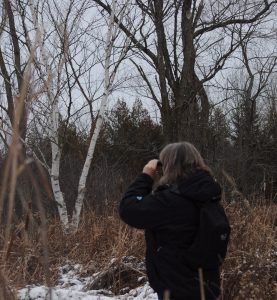 There are far fewer bird species around during the winter months, which can, perhaps counterintuitively, make bird watching more enjoyable. For newcomers to birding, fewer species means a less overwhelming learning curve. Many of the species that overwinter here stay for the spring and summer, making winter a good time to establish a solid knowledge base in time for the return of the spring migrants. Many experienced birders are inclined to “capture” as many species as possible on an outing. For them, fewer species in winter can encourage a slowing down that allows more time for watching individuals and learning more about different species’ behaviours, instead of running off to spot the next species.
There are far fewer bird species around during the winter months, which can, perhaps counterintuitively, make bird watching more enjoyable. For newcomers to birding, fewer species means a less overwhelming learning curve. Many of the species that overwinter here stay for the spring and summer, making winter a good time to establish a solid knowledge base in time for the return of the spring migrants. Many experienced birders are inclined to “capture” as many species as possible on an outing. For them, fewer species in winter can encourage a slowing down that allows more time for watching individuals and learning more about different species’ behaviours, instead of running off to spot the next species.
So, if you want to try a winter bird walk, here are a few tips to help you get the most from it.
Learn which species you can expect to see
Your local field guide can help, but it’s possible to get far more detailed location-specific information online. eBird is an incredible citizen-driven database housed by Cornell University. You can search by location and get a list of the species documented there, Even more cool is the illustrated checklist, which lists each species with a photograph and audio recording (where available) and a timeline showing how often they occur throughout the year. Check out the illustrated checklist for the Peterborough area.
Know your destination
You don’t necessarily have to travel far to have a good birdwatching experience in the winter. The combination of fewer species plus birds’ heavier reliance on bird feeders during the colder months, all you need to do is scout your neighbourhood to get to know where all the active feeders and heated bird baths are!
Dress warmly
First, don’t wear cotton! It loses all insulative value when it gets wet, which can happen from the outside via weather or the inside via sweat.
Wearing the right 3+ layers made of the right materials will make a huge difference. (1) The innermost layer should be a material that wicks moisture away from your body. This layer is often a synthetic such as polypropylene, an athletic shirt, or fleece. (2) The second layer should be insulative, something thick with air spaces that won’t lose its insulative value if it gets wet. Wool or synthetic fleeces work well here. (3) The outer layer should be a windproof shell (which might also be insulated).
Bring the right stuff
In addition to the obvious – binoculars and a field guide – have a backpack with an extra layer, enough room to put a shed layer in if you get too warm, and a thermos with a warm drink in it. You might want a notebook or a voice recorder to keep track of what you see.
You may discover that when you use your binoculars to look high up, your rising body heat will cause the lenses to fog up. Consider cleaning your lenses with an anti-fog spray before you head out and bringing a lint-free glasses cleaning cloth with you.
Bring the right people
Birdwatching can be an enjoyable social activity. Choose companions whose company you enjoy!
